初中英语八种时态归纳总结表格版资料讲解
八种时态归纳总结表格版

Past Continuous Tense
was/were+现在分词(v.-ing)
表示过去某个时刻正在进行的动作或状态
She was watching TV at seven o'clock yesterday evening.(昨天晚上七点她正在看电视。)
现在完成时
Present Perfect Tense
have/has+过去分词(v.-ed)
表示从过去某个时间开始一直持续到现在的动作或状态,以及过去某一时间点到现在的经历或结果
They have finished their work.(他们已经完成了他们的工作。)
过去完成时
Past Perfect Tense
had+过去分词(v.-ed)
表示在过去某一时间或动作之前已经完成的动作或状态,即“过去的过去”
She had already seen the movie before.(她以前已经看过这部电影了。)
一般将来时
Simple Future Tense
will/shall+动词原形(v.)
表示将来某个时间将要发生的动作或状态,以及Fra bibliotek来的计划或安排
We will go to the park tomorrow.(我们明天要去公园。)
过去将来时
Past Future Tense
would+动词原形(v.)
表示从过去某个时间看将要发生的动作或状态,常用于宾语从句或间接引语中
She said she would come back soon.(她说她很快就会回来。)
be动词+现在分词(v.-ing)
初中英语八大时态表格

初中英语八大时态表格时态名称结构(以动词do为例)用法示例常见时间状语一般现在时do/doesI often play basketball.(表示经常或习惯性的动作)<br>He likes reading.(表示现在的状态、事实或真理)always, usually, often, sometimes, every day/week/month/year等一般过去时didI went to the park yesterday.(表示过去某个时间发生的动作或存在的状态)yesterday, last week/month/year, just now, a moment ago等一般将来时will/shall do(第一人称常用shall),be going to doI will go to Beijing next week.(表示将来某个时间要发生的动作或存在的状态)<br>He is going to study hard.(表示打算、计划做某事)tomorrow, nextweek/month/year, in + 一段时间等现在进行时am/is/are doingShe is reading a book now.(表示此时此刻正在进行的动作)now, at the moment, look, listen等提示词出现时过去进行时was/were doingI was doing my homework when he came in.(表示过去某个时刻正在进行的动作,常与一般过去时搭配使用)at this time yesterday, from 7 to 9 last night等现在完成时have/has doneI have already finished my homework.(表示过去发生的动作对现在造成的影响或结果)<br>He has lived here for ten years.(表示过去已经开始,持续到现在的动作或状态)already, yet, just, ever, never, for + 时间段, since + 时间点等过去完成时had doneWhen I got to the station, the train had already left.(表示在过去某个时间或动作之前已经发生或完成的动作,即“过去的过去”)by the end of last year, before + 一般过去时的句子等将来进行时will be doingI will be having a meeting at this time tomorrow.(表示将来某个时刻或时间段正在进行的动作)at this time tomorrow等。
初中英语八种时态归纳表格

时态 一 般 现 在 时
一 般 过 去 时
备注
时间状语
结构及变化:
注意客观真理:The earth goes around the sun.
三单:he,she ,it,my father , always, usually, often ,
Tom,water,the book..... sometimes,every week(day,
①be 动词: 肯定:I am a teacher. 否定:You aren’t an artist? 问:Is he a scientist? 特:What are they?
①be 动词: 肯定:I was a teacher. 否定:You weren’t an artist? 问:Was he a scientis? 特殊:What were they?
Before he arrived, the train had left.(表过去的过去)
基本结构: 肯定: was/were going to + do
②would +do . 肯定:主语+ would + 动词原形 否定:主语+ would not (wouldn’t) + 动词原形 问句:Would 主语+ 动词原形 ?
般 There be 句型将来时态:
soon,
否:You aren’t going to be an 否定:You won't play basketball with me.问
将 there will be
the day after tomorrow
artist?
句:Will she go to Beijing ?
初中英语时态总结表格
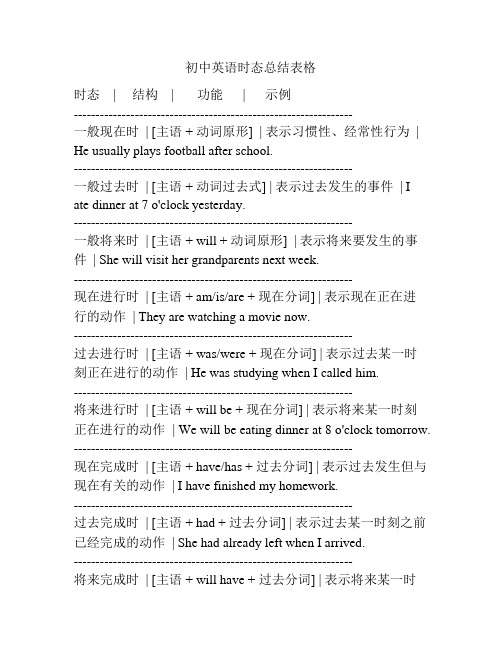
初中英语时态总结表格时态 | 结构 | 功能 | 示例----------------------------------------------------------------一般现在时 | [主语 + 动词原形] | 表示习惯性、经常性行为 | He usually plays football after school.----------------------------------------------------------------一般过去时 | [主语 + 动词过去式] | 表示过去发生的事件 | I ate dinner at 7 o'clock yesterday.----------------------------------------------------------------一般将来时 | [主语 + will + 动词原形] | 表示将来要发生的事件 | She will visit her grandparents next week.----------------------------------------------------------------现在进行时 | [主语 + am/is/are + 现在分词] | 表示现在正在进行的动作 | They are watching a movie now.----------------------------------------------------------------过去进行时 | [主语 + was/were + 现在分词] | 表示过去某一时刻正在进行的动作 | He was studying when I called him.----------------------------------------------------------------将来进行时 | [主语 + will be + 现在分词] | 表示将来某一时刻正在进行的动作 | We will be eating dinner at 8 o'clock tomorrow. ----------------------------------------------------------------现在完成时 | [主语 + have/has + 过去分词] | 表示过去发生但与现在有关的动作 | I have finished my homework.----------------------------------------------------------------过去完成时 | [主语 + had + 过去分词] | 表示过去某一时刻之前已经完成的动作 | She had already left when I arrived.----------------------------------------------------------------将来完成时 | [主语 + will have + 过去分词] | 表示将来某一时刻之前已经完成的动作 | By this time next year, we will have graduated from high school.----------------------------------------------------------------情态动词 | [情态动词 + 动词原形] | 表示能力、意愿、推测等 | She can swim very well.----------------------------------------------------------------。
八大时态讲解

一般将来时的注意点:
be going to 与 will /shall区别: be going to 指当前的、已计划过或思考过的意图 和打算;
如:I am going to listen to music. (我打算听音乐 )
will /shall 表示未事先思考或为计划过的意图 如:It will be Christmas soon .(很快就圣诞节了 )
3.一般将来时态(The Simple Future Tense)
概念:表示将来某个时间要发生的动作或存
在的状态
谓语动词形式
:12..
will/shall+do am/is/are going
to+do
3. am/is/are + doing
常用时间状语 :
tomorrow, in three days,this…,
• 将来完成时: We will have had our exam by September 20.
• 过去将来完成时: He told them he would have finished by 9 o’clock.
英语的动词时态(完成进行)
• 现在完成进行时: Obviously she’s been crying. It has been snowing all night. The ground is covered with thick snow.
• 一般将来时: We will have a test next month. He is going to buy her some flowers.
• 一般过去将来时: He was sixty-eight. In two years he would be seventy. I knew you would agree.
初中英语八种时态归纳表格
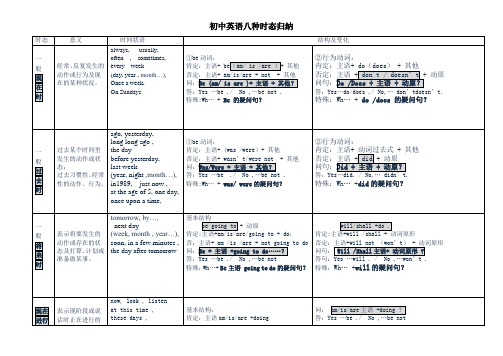
recently,
基本结构:
lately,
since+ 时间点
肯定:主语+ have/has+ done(动词的过去分词)
for+ 时间段。
否定:主语 have/has+ not+ done. (动词的过去分词)
=(since + 时间点 ago) 问句:主语+have/ has + done(动词的过去分词)?
now, look , listen at this time , these days ,
基本结构: 肯定:主语 am/is/are +doing
问: am/is/are 主语 +doing ? 答:Yes …be ./ No ,…be not
时 动作及行为。
否定:主语 am/is/are+ not + doing.
答:Yes …have /has ./ No ,…have/has not .
in the past few years, 特殊:Wh…+ have/has 主语 + 疑问句?
注意:当与一段时间连用时,动词要改为延 续性动词。 have bought =have been had have borrow = have kept have died = have been dead ………… have been to : have gone to : have been in :
准备做某事。
答:Yes …be ./ No ,…be not
问句: Will /Shall 主语+ 动词原形 ? 答句:Yes …will . / No ,…won’t .
初中英语八种时态归纳表格

以 过 去 某 个 before, 过
基本结构:
时间为标准,
肯定:主语+ had + done(动词的过去分词)
去
by the end of last
在此以前发
否定:主语 had not+ done.(动词的过去分词)
完
year
生的动作或
问句:主语+ had + done(动词的过去分词)
成
(term,month…);
肯定:主语+ (was /were)+ 其他 肯定:主语+ 动词过去式 + 其他
动作或状态; the day
否定:主语+ wasn’t/were not + 否定:主语 + did + 动原
过去习惯性、 before
其他
经常性的动
般 作、行为。 yesterday, last week
问:Was/Were + 主语 + 其他 问句:Did + 主语 + 动原 答:Yes …be ./ No ,…be not . 答:Yes…did. / No,… didn’t.
或准备做某
形
事。
soon, in a few 否:主语+ am /is /are + not going
将
minutes ,
to do
问句: Will /Shall 主语+ 动词原形
the day after 问:Be + 主语 +going to do…… 答句:Yes …will . / No ,…won’t .
来
tomorrow
初中时态语态总结表格
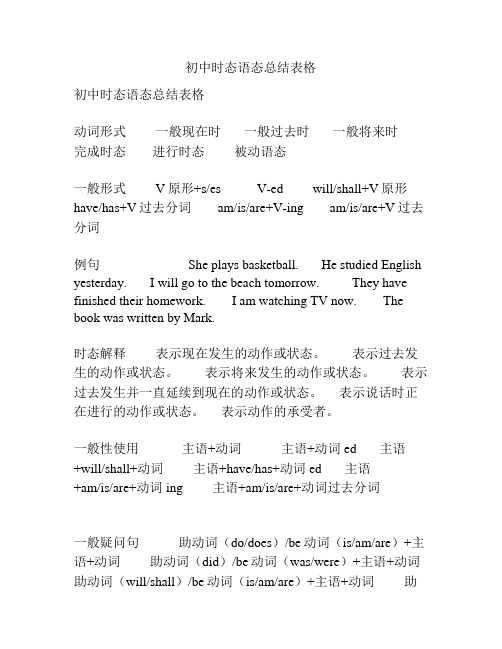
初中时态语态总结表格初中时态语态总结表格动词形式一般现在时一般过去时一般将来时完成时态进行时态被动语态一般形式 V原形+s/es V-ed will/shall+V原形have/has+V过去分词 am/is/are+V-ing am/is/are+V过去分词例句 She plays basketball. He studied English yesterday. I will go to the beach tomorrow. They have finished their homework. I am watching TV now. The book was written by Mark.时态解释表示现在发生的动作或状态。
表示过去发生的动作或状态。
表示将来发生的动作或状态。
表示过去发生并一直延续到现在的动作或状态。
表示说话时正在进行的动作或状态。
表示动作的承受者。
一般性使用主语+动词主语+动词ed 主语+will/shall+动词主语+have/has+动词ed 主语+am/is/are+动词ing 主语+am/is/are+动词过去分词一般疑问句助动词(do/does)/be动词(is/am/are)+主语+动词助动词(did)/be动词(was/were)+主语+动词助动词(will/shall)/be动词(is/am/are)+主语+动词助动词(have/has)/be动词(is/am/are)+主语+动词ed 助动词(am/is/are)/be动词(is/am/are)+主语+ 动词ing 助动词(am/is/are)/be动词(is/am/are)+主语+动词过去分词特殊疑问句疑问词+助动词(do/does)/be动词(is/am/are)+主语+动词疑问词+助动词(did)/be动词(was/were)+主语+动词疑问词+助动词(will/shall)/be 动词(is/am/are)+主语+动词疑问词+助动词(have/has)/be动词(is/am/are)+主语+动词ed 疑问词+助动词(am/is/are)/be动词(is/am/are)+主语+ 动词ing 疑问词+助动词(am/is/are)/be动词(is/am/are)+主语+动词过去分词否定句主语+助动词(do not/does not)/be动词(is/am/are not)+动词主语+助动词(did not)/be动词(was/were not)+动词主语+助动词(will/shall not)/be动词(is/am/are not)+动词主语+助动词(have/has not)/be 动词(is/am/are not)+动词ed 主语+助动词(am not/is not/are not)/be动词(is/am/are not)+动词ing 主语+助动词(am not/is not/are not)/be动词(is/am/are not)+动词过去分词情态动词主语+情态动词+动词原形主语+情态动词+动词原形主语+will/shall+情态动词+动词原形主语+have/has+情态动词+动词原形主语+am/is/are+情态动词+ 动词ing 主语+am/is/are+情态动词+动词过去分词现在进行时主语+am/is/are+V-ing 主语+was/were+V-ing 主语+will/shall+be+V-ing 主语+have/has+been+V-ing - -过去进行时主语+was/were+V-ing -- - - -将来进行时主语+will/shall+be+V-ing -- - - -完成进行时主语+have/has+been+V-ing 主语+had+been+V-ing - -- -被动语态主语+am/is/are+V过去分词主语+was/were+V过去分词主语+will/shall+be+V过去分词主语+have/has+been+V过去分词主语+am/is/are+being+V过去分词主语+am/is/are+V过去分词。
(完整版)初中英语八种时态归纳总结表格版
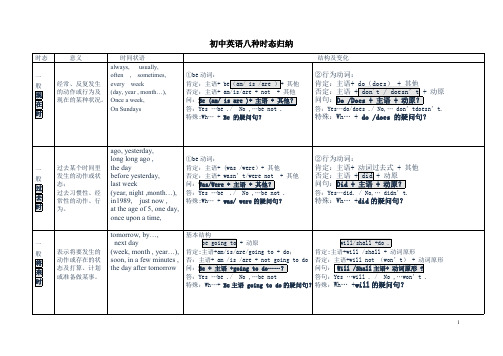
特殊:Wh… + was/ were 的疑问句?
特殊:Wh… +did 的疑问句?
时 为。
at the age of 5, one day,
once upon a time,
tomorrow, by…,
基本结构
一
next day
be going to + 动原
will/shall +do .
般 表示将要发生的 (week, month , year…), 肯定:主语+am/is/are/going to + do;
问句: Will /Shall 主语+ 动词原形 ?
或准备做某事。
答:Yes …be ./ No ,…be not
答句:Yes …will . / No ,…won’t .
时
特殊:Wh…+ Be 主语 going to do 的疑问句?特殊:Wh… +will 的疑问句?
1
The shortest way to do many things is to only one thin
②would +do . 肯定:主语+ would + 动词原形 否定:主语+ would not (wouldn’t) + 动词原形 问句:Would 主语+ 动词原形 ? 答句:Yes …would. / No ,…wouldn’t .
特殊:Wh… +would 的疑问句?
2
The shortest way to do many things is to only one thin
The next day (morning,year…), the following month (week…)
初中英语时态总结表格
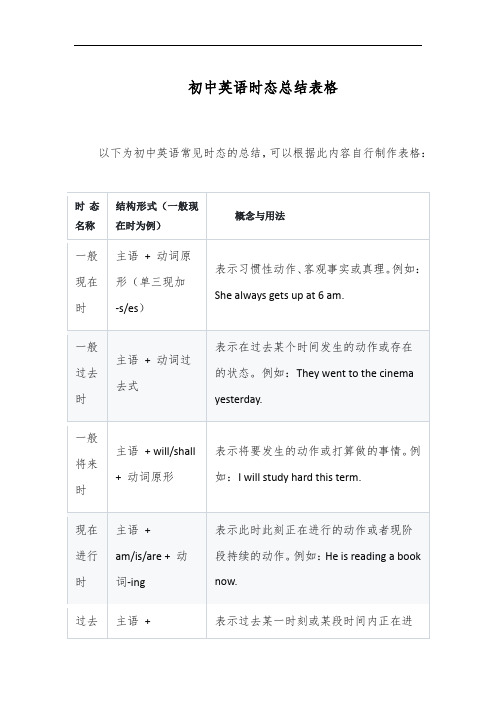
主语+was/were +动词-ing
表示过去某一时刻或某段时间内正在进行的动作。例如:At 8 o'clock last night, they were watching TV.
将来进行时
主语+ will be +动词-ing
表示将来某一时刻正在进行的动作。例如:This time next week, I will be travelling in Europe.
初中英语时态总结表格
以下为初中英语常见时态的总结,可以根据此内容自行制作表格:
时态名称
结构形式(一般现在时为例)
概念与用法
一般现在时
主语+动词原形(单三现加-s/es)
表示习惯性动作、客观事实或真理。例如:She always gets up at 6 am.
一般过去时
主语+动词过去式
表示在过去某个时间发生的动作或存在的状态。例如:They went to the cinema yesterday.
一般将来时
主语+ will/shall +动词原 hard this term.
现在进行时
主语+ am/is/are +动词-ing
表示此时此刻正在进行的动作或者现阶段持续的动作。例如:He is reading a book now.
现在完成时
主语+ have/has +过去分词
表示过去发生的动作对现在造成的影响或结果,或者从过去开始一直持续到现在的动作。例如:She has lived here for 5 years.
过去完成时
主语+ had +过去分词
初中英语八种时态一览表 (精华版)

初中英语八种时态一览表 (精华版)作发生在现在之前,常用于叙述过去的经历和事件。
通常与具体时间状语连用,如yesterday。
last week。
two years ago 等。
例如:Yesterday。
I went to the park with my friends.现在进行时表示现在正在进行的动作或状态。
通常用于现在时态的句子中,使用现在分词形式。
例如:I am studying English now.过去进行时表示过去某一时刻正在进行的动作或状态。
通常与具体时间状语连用,如yesterday at this time。
while I was cooking dinner等。
使用过去式be动词(were/was)和动词的现在分词形式。
例如:I was watching TV when he called me.一般将来时表示将要发生的动作或状态。
通常用于表示未来的计划或打算。
使用will/shall加动词原形。
例如:I will go to the XXX.过去将来时表示过去某个时间点将要发生的动作或状态。
通常与具体时间状语连用,使用过去式be动词(were/was)和动词的原形。
例如:Yesterday at this time。
I was going to theparty with my friends.现在完成时表示过去发生的动作对现在的影响或过去延续到现在的动作或状态。
使用have/has加动词的过去分词形式。
例如:I have finished my homework。
so I can relax now.过去完成时表示过去某个时间点之前已经完成的动作或状态。
通常与具体时间状语连用,使用had加动词的过去分词形式。
例如:By the time I arrived。
he had already left.需要使用连词that来引导。
When writing an article。
英语8大时态总结表格

英语8大时态总结表格时态概述英语中有8大时态,它们用于表达不同时间和状态。
下面是关于这些时态的详细总结表格。
时态结构用法一般现在时主语 + 动词原形表示经常性、习惯性或普遍真理一般过去时主语 + 动词过去式表示过去发生的动作或状态一般将来时主语 + will + 动词原形表示将来发生的动作或状态现在进行时主语 + be + 动词-ing 表示现在进行的动作或状态过去进行时主语 + was/were + 动词-ing 表示过去某一时间正在进行的动作将来进行时主语 + will be + 动词-ing 表示将来某一时间正在进行的动作现在完成时主语 + have/has + 过去分词表示过去某一时间到现在的持续动作过去完成时主语 + had + 过去分词表示过去某一时间到过去的持续动作详细解释一般现在时一般现在时表示经常性、习惯性或普遍真理。
它的结构是主语 + 动词原形。
例如:•I go to school every day.•She likes to read books.•The sun rises in the east.一般过去时一般过去时表示过去发生的动作或状态。
它的结构是主语+ 动词过去式。
例如:•I went to the park yesterday.•They played soccer last week.•She bought a new car two years ago.一般将来时一般将来时表示将来发生的动作或状态。
它的结构是主语 + will + 动词原形。
例如:•I will travel to Japan next month.•They will have a party tomorrow.•She will call you later.现在进行时现在进行时表示现在正在进行的动作或状态。
它的结构是主语+ be + 动词-ing。
例如:•I am studying for the exam.•She is watching TV right now.•They are playing basketball in the park.过去进行时过去进行时表示过去某一时间正在进行的动作。
初中英语八大时态结构表总结
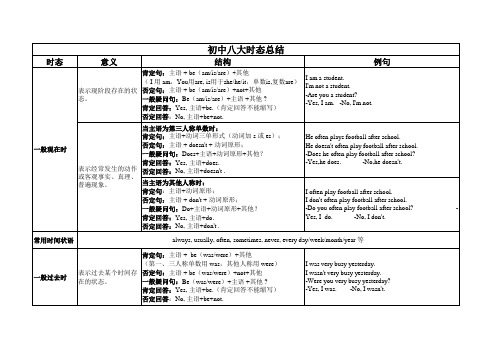
否
By the end of last year, we had learned 2000 English words.
常用时间状语 by the end of + 过去时间, before + 过去时间 等
常用时间状语
the next day/week/month/year 等
现在进行时
表示现在正在进行的 动作。
主语 + am/is/are + 现在分词(动词的 -ing 形式)
She is reading a book now. Listen! They are singing. We are having an English class at the moment.
-Have you finished your homework yet?
-Yes,I have.
-No, I haven't.
He has lived here since ten years ago.=He has lived here for ten years.
常用时间状语 already, yet, just, ever, never,so far= up tp now, since + 时间点, for + 时间段 等
过去将来时
从过去的某一时间来 would + 动词原形
看将来要发生的动作
或存在的状态。
was/were going to + 动词原形
He said he would come back the next day. They were going to visit the museum the following week.
(完整word版)初中英语八大时态表
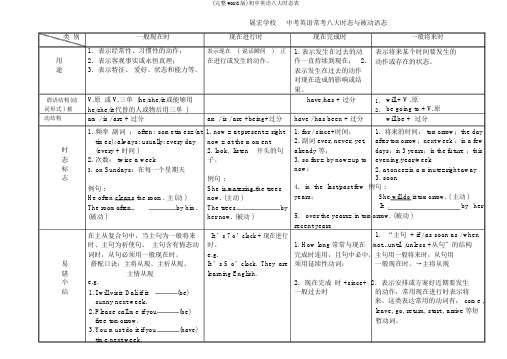
展宏学校中考英语常考八大时态与被动语态类别一般现在时现在进行时现在完成时一般将来时用途谓语结构(动词形式 ) 被动结构时态标志1.表示经常性、习惯性的动作;表示现在(说话瞬间)正2.表示客观事实或永恒真理;在进行或发生的动作。
3.表示特征、爱好、状态和能力等。
V.原或 V.三单 (he/she/it 或能够用he/she/it 代替的人或物后用三单 )am / is / are + 过分am / is / are +being+过分1. 频率副词: often;sometimes=(at 1. now = at present = righttimes); always; usually; every day now = at the moment(every + 时间 ) 2. look, listen开头的句2. 次数: twice a week子。
3. on Sundays:在每一个星期天例句 :例句 :She is watering the treesHe often cleans the room. 主(动 )now. (主动 )The roomoften by him.The trees by(被动 )her now. (被动 )1. 表示发生在过去的动表示将来某个时间要发生的作一直持续到现在; 2.动作或存在的状态。
表示发生在过去的动作对现在造成的影响或结果。
have/has + 过分 1.will + V .原2.be going to + V.原have / has been + 过分will be + 过分1. for / since+时间; 1.将来的时间: tomorrow;the day2. 副词 ever, never, yet,after tomorrow;next week ;in a fewalready 等;days;in 3 years;in the future ;this3. so far = by now=up to evening/year/weeknow; 2. at once=in a minute=right away3.soon4.in the last/past few 例句 :years;She will do it tomorrow. ( 主动 )It by her5.over the years= in tomorrow. (被动 )recent years在主从复合句中,当主句为一般将来It ’s 7 o’clock + 现在进行时、主句为祈使句、主句含有情态动时。
初中英语八种时态归纳总结表格版

问:Be + 主语 +going to
答句:Yes …would. /
do……?
No ,…wouldn’t .
答:Yes …be ./ No ,…be
特殊:Wh… +would 的疑问句?
not
特殊:Wh…+ Be 主语 going
to do 的疑问句?
.4
初中数学教材版本统计
.5
在 或说话时正在进
at this
进 行的动作及行为。 time
初中数学教材版本统计
基本结构: 肯定:主语 am/is/are +doing 否定:主语 am/is/are+ not + doing.
问: am/is/are 主语 +doing ? 答:Yes …be ./ No ,…be not 特殊:Wh…+ Be 主语 + 疑问句?
before
时 经常性的动作、行 yesterday,
为。
last
①be 动词: 肯定:主语+ (was /were)+ 其 他 否定:主语+ wasn’t/were not + 其他 问:Was/Were + 主语 + 其 他? 答:Yes …be ./
.1
②行为动词: 肯定:主语+ 动词过去式 + 其他 否定:主语 + did + 动原 问句:Did + 主语 + 动原?
before, by the end of last year (term,month …); 过去时态的从句
The next day (morning,ye ar…), the following month (week…)
初中英语八种时态归纳总结表格版(完整资料).doc

过
过去习惯 night ,month…), 问:Was/Were + 主语 + 其 性、经常性 in1989, just now , 他?
特殊:Wh… +did 的疑问句?
去 的动作、行 at the age of 5, one 答:Yes …be ./ No ,…be not .
为。
day,
特殊:Wh… + was/ were 的疑问
进 一时刻正在 或 when 引导的一
行 发生或进行 般过去时的时间
时 的行为或动 状语
作
问:Was /Were 主语 +doing ? 答:Yes …was/ were ./ No ,…was /were not 特殊:Wh…+ Be 主语 + 疑问句?
过去发 recently,
基本结构:
注意:当与一段时间连用时,
时 果,
ago)
或从过去已 in the past few
过去分词) 问句:主语+have/ has + done(动词的过去
have died = have been
经开始,持 years,
分词)?
dead …………
续到现在的 动作或状
答:Yes …have /has ./ No ,…have/has not . have been to :
+ 其他
否定:主语 + don't / doesn’t + 动原
否定:主语+ am/is/are + not + 问句:Do /Does + 主语 + 动原?
现 在的某种状 month…),
初中英语8个动词时态时间轴、时态结构搭配图、时态简表、时态复习讲义
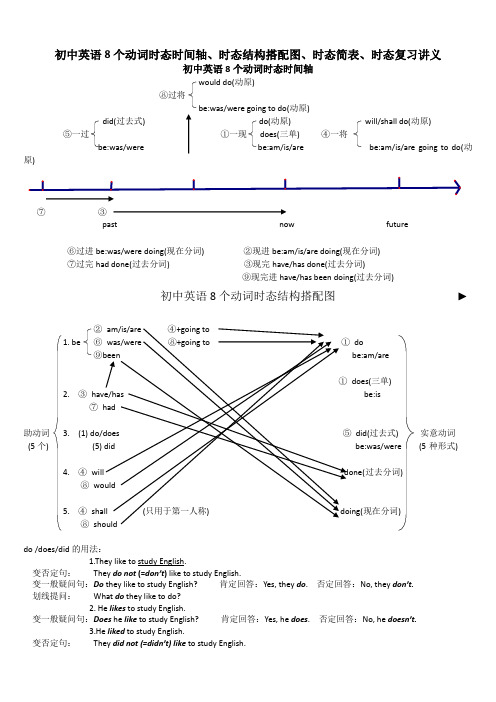
初中英语8个动词时态时间轴、时态结构搭配图、时态简表、时态复习讲义初中英语8个动词时态时间轴would do(动原)⑧过将be:was/were going to do(动原)did(过去式) do(动原) will/shall do(动原)⑤一过①一现does(三单) ④一将be:was/were be:am/is/are be:am/is/are going to do(动原)⑦③past now future⑥过进be:was/were doing(现在分词) ②现进be:am/is/are doing(现在分词)⑦过完had done(过去分词) ③现完have/has done(过去分词)⑨现完进have/has been doing(过去分词)初中英语8个动词时态结构搭配图②am/is/are ④+going to1. be ⑥was/were ⑧+going to ①do⑨been be:am/are①does(三单)2. ③have/has be:is⑦had助动词 3. (1) do/does ⑤did(过去式) 实意动词(5个) (5) did be:was/were (5种形式)4. ④will done(过去分词)⑧would5. ④shall (只用于第一人称) doing(现在分词)⑧shoulddo /does/did的用法:1.They like to study English.变否定句:They do not (=don’t) like to study English.变一般疑问句:Do they like to study English? 肯定回答:Yes, they do. 否定回答:No, they don’t.划线提问:What do they like to do?2. He likes to study English.变一般疑问句:Does he like to study English? 肯定回答:Yes, he does. 否定回答:No, he doesn’t.3.He liked to study English.变否定句:They did not (=didn’t) like to study English.初中英语8个动词时态简表(表格+图表)初中英语8个动词时态复习讲义一般现在时一、动词的第三人称词尾变化:写出下列动词的单数第三人称形式。
初中英语八种时态归纳表格

过去 完成 时
以过去某个时间 为标准,在此以前 发生的动作或行 为,或在过去某动 作之前完成的行 为,即“过去的过 去”
before,
;
by the end of last year (term,month…); 过去时态的从句
基本结构: 肯定:主语+ had + done(动词的过去分词) 否定:主语 had not+ done.(动词的过去分词) 问句:主语+ had + done(动词的过去分词) 答:Yes …had./ No ,…had not .
`
基本结构: 肯定:主语 was /were +doing 否定:主语 was /were not + doing.
问:Was /Were 主语 +doing 答:Yes …was/ were ./ No ,…was /were not 特殊:Wh…+ Be 主语 + 疑问句
【
现在 完成 时
过去发生或已 经完成的动作对 现在造成的影响 或结果, 或从过去已经开 始,持续到现在的 动作或状态。
将
态及打算、计划或 soon, in a few 准备做某事。 minutes ,
…
问:Be + 主语 +going to do……
来
the day after tomorrow 答:Yes …be ./ No ,…be not
时Leabharlann ②行为动词: 肯定:主语+ 动词过去式 + 其他
`
否定:主语 + did + 动原 问句:Did + 主语 + 动原
,
问句:Do /Does + 主语 + 动原
- 1、下载文档前请自行甄别文档内容的完整性,平台不提供额外的编辑、内容补充、找答案等附加服务。
- 2、"仅部分预览"的文档,不可在线预览部分如存在完整性等问题,可反馈申请退款(可完整预览的文档不适用该条件!)。
- 3、如文档侵犯您的权益,请联系客服反馈,我们会尽快为您处理(人工客服工作时间:9:00-18:30)。
注意:当与一段时间连用时,动词要改为延 续性动词。 have bought =have been had have borrow = have kept have died = have been dead ………… have been to : have gone to : have been in :
精品文档
时态
一 般 现 在 时
意义
经常、反复发生的 动作或行为及现 在的某种状况。
时间状语
always, usually, often , sometimes, every week (day, year , month…), Once a week, On Sundays
初中英语八种时态归纳
①be 动词: 肯定:主语+ be(am/ is /are )+ 其他 否定:主语+ am/is/are + not + 其他 问:Be (am/ is are )+ 主语 + 其他? 答:Yes …be ./ No ,…be not . 特殊:Wh… + Be 的疑问句?
recently,
基本结构:
lately,
since+ 时间点
肯定:主语+ have/has+ done(动词的过去分词)
for+ 时间段。
否定:主语 have/has+ not+ done. (动词的过去分词)
=(since + 时间点 ago) 问句:主语+have/ has + done(动词的过去分词)?
long long ago ,
①be 动day
肯定:主语+ (was /were)+ 其他
肯定:主语+ 动词过去式 + 其他
般 发生的动作或状 before yesterday,
否定:主语+ wasn’t/were not + 其他 否定:主语 + did + 动原
结构及变化
②行为动词: 肯定:主语+ do(does) + 其他 否定:主语 + don't / doesn’t + 动原 问句:Do /Does + 主语 + 动原?
答:Yes…do/does ./ No,… don’tdoesn’t.
特殊:Wh… + do /does 的疑问句?
ago, yesterday,
答:Yes…did. / No,… didn’t.
特殊:Wh… +did 的疑问句?
时
at the age of 5, one day,
once upon a time,
tomorrow, by…,
基本结构
一
next day
be going to + 动原
will/shall +do .
般 表示将要发生的 (week, month , year…), 肯定:主语+am/is/are/going to + do;
准备做某事。
答:Yes …be ./ No ,…be not
问句: Will /Shall 主语+ 动词原形 ? 答句:Yes …will . / No ,…won’t .
时
特殊:Wh…+ Be 主语 going to do 的疑问句? 特殊:Wh… +will 的疑问句?
精品文档
精品文档
现在 进行 时
表示现阶段或说 话时正在进行的 动作及行为。
now, look , listen at this time , these days ,
基本结构: 肯定:主语 am/is/are +doing 否定:主语 am/is/are+ not + doing.
问: am/is/are 主语 +doing ? 答:Yes …be ./ No ,…be not 特殊:Wh…+ Be 主语 + 疑问句?
过 去
态;
last week
过去习惯性、经常 (year, night ,month…),
性的动作、行为。 in1989, just now ,
问:Was/Were + 主语 + 其他? 答:Yes …be ./ No ,…be not . 特殊:Wh… + was/ were 的疑问句?
问句:Did + 主语 + 动原?
过去 进行 时
现在 完成 时
过去 完成 时
过去 将来 时
表示过去某段时 间或某一时刻正 在发生或进行的 行为或动作
过去发生或已 经完成的动作对 现在造成的影响 或结果, 或从过去已经开 始,持续到现在的 动作或状态。
以过去某个时间 为标准,在此以前 发生的动作或行 为,或在过去某动 作之前完成的行 为,即“过去的过 去” 立足于过去某一 时刻,从过去看将 来,常用于宾语从 句中
肯定:主语+will /shall + 动词原形
将 动作或存在的状 soon, in a few minutes , 否:主语+ am /is /are + not going to do 否定:主语+will not (won’t) + 动词原形
来
态及打算、计划或 the day after tomorrow 问:Be + 主语 +going to do……?
At this time yesterday ,at that time , 或 when 引导的一般过去 时的时间状语
基本结构: 肯定:主语 was /were +doing 否定:主语 was /were not + doing.
问:Was /Were 主语 +doing ? 答:Yes …was/ were ./ No ,…was /were not 特殊:Wh…+ Be 主语 + 疑问句?
in the past few years, 答:Yes …have /has ./ No ,…have/has not .
特殊:Wh…+ have/has 主语 + 疑问句?
before, by the end of last year (term,month…); 过去时态的从句
基本结构: 肯定:主语+ had + done(动词的过去分词) 否定:主语 had not+ done.(动词的过去分词) 问句:主语+ had + done(动词的过去分词)? 答:Yes …had./ No ,…had not .
The next day (morning,year…), the following month (week…)
